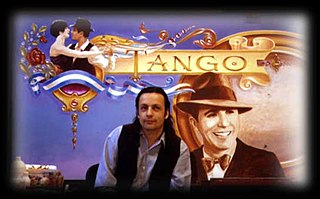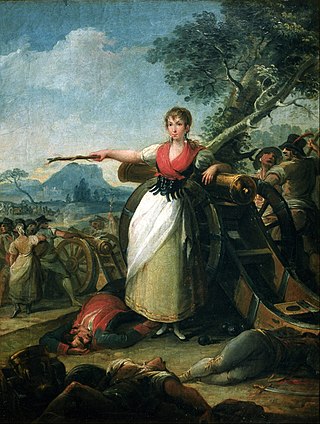
The Layos Sarcophagus is a paleochristian sarcophagus found in Layos, Toledo in 1627 and now in Barcelona.
Contents
The iconography is focused on the dogma of the Incarnation, and it is opposed to docetism and monophysitism. [1]

The Layos Sarcophagus is a paleochristian sarcophagus found in Layos, Toledo in 1627 and now in Barcelona.
The iconography is focused on the dogma of the Incarnation, and it is opposed to docetism and monophysitism. [1]
The original is kept at the Museu Frederic Marès in Barcelona. [2] In October 2007 two replicas arrived in Castilla La Mancha. One was put on show at the Visigothic Museum (Museo de los Concilios y de la Cultura Visigoda). [3]
There is another sarcophagus from Layos in the Real Academia de la Historia. [4]

The National Archaeological Museum is a museum in Madrid, Spain. It is located on Calle de Serrano beside the Plaza de Colón, sharing its building with the National Library of Spain.

Félix de la Concha is a painter. Born in León, Spain, he resides in Pittsburgh and Madrid.

Manuel Salvador Carmona was a Spanish engraver, designer and illustrator. Two of his brothers were also artists: José Salvador Carmona, a sculptor, and Juan Antonio Salvador Carmona, also an engraver.

Layos is a municipality located in the province of Toledo, Castile-La Mancha, Spain. According to the 2006 census (INE), the municipality has a population of 378 inhabitants. In Layos in 1627 it was found the paleochristian sarcophagus named Layos Sarcophagus.
Francisco de Asís Monterde García Icazbalceta was a prolific and multifaceted Mexican writer whose career spanned over fifty years. He was an important promoter of the arts and culture in Mexico in the years following the Revolution.

Manuel Tuñón de Lara (1915–1997) was a Spanish historian.

Iris M. Zavala was a Puerto Rican author, scholar, and poet, who later lived in Barcelona, Spain. She had over 50 works to her name, plus hundreds of articles, dissertations, and conferences and many of her writings, including "Nocturna, mas no funesta", build on and express this belief.

Augusto Ferrer-Dalmau Nieto is a Spanish hyperrealist painter who specialises in historical military paintings that portray different eras of the Spanish Armed Forces through hyperrealistic naturalism. On January 11, 2022, he presented the Ferrer-Dalmau Foundation with the aim of promoting defense culture through history and art.

Jorge Muscia is a plastic artist and ‘fileteado’ instructor with over 30 years of experience in his field. Muscia, also known as the Fileteador of Tango, distinguishes himself for being a force in the revival of this old style of painting and for being a renowned instructor and promoter of the art of the filete in Argentina and the world.
Justino Fernández García was a researcher, historian and art critic who is particularly known for his work documenting and critiquing Mexican art of the 20th century. Fernandez studied and developed his career with the National Autonomous University of Mexico, as a protégé of Manuel Toussaint. Then the latter died in 1955, Fernandez took over as head of the Aesthetic Research Institute at UNAM, where he would develop the most of his writing and research until his death. Fernandez’s work was recognized by the Mexican government with the Premio Nacional de Ciencias y Artes in 1969.

Jean Laurent or, in Spanish, Juan Laurent Minier; sometimes simply J. Laurent was a French photographer who mostly worked in Spain.

Gardening in Spain reflects the different styles of Spanish art, including influences from Roman, Islamic, Italian, French, and English gardens. Modern Spanish gardening emphasize gardens and their surroundings, focusing heavily on both urban horticulture and landscape architecture.

Roman villa of Camino de Albalate is a Roman site near Calanda, Teruel, Aragon, Spain. The archaeological site, now dismantled, is located in the Albalate orchard area and is one of the most significant sites in the province of Teruel. The mosaic discovered there stands as the primary example of Roman culture in the aforementioned province.

Faustina Sáez de Melgar, née Faustina Sáez y Soria (1834–1895) was a Spanish writer and journalist. She was mother of the composer and painter Gloria Melgar Sáez.
Francisco Javier Sánchez Cantón (1891–1971) was a Spanish art historian, who from 1960 to 1968 was Director of the Museo del Prado.

Juan Gálvez was a Spanish artist who served as court painter for King Ferdinand VII and Director of the Real Academia de Bellas Artes de San Fernando.

Juan Antonio Salvador Carmona was a Spanish engraver. His older brother, Manuel Salvador Carmona, was also an engraver and his eldest brother, José Salvador Carmona, was a sculptor.

Agapit Vallmitjana i Barbany was a Spanish sculptor, in the Realist style. His brother Venanci was also a sculptor, with whom he usually collaborated.

Valeriano Bozal Fernández was a Spanish historian and philosopher. He was a participant in the collaborative project Enciclopedia del Museo del Prado.
{{cite book}}: CS1 maint: location missing publisher (link){{cite book}}: CS1 maint: location missing publisher (link)